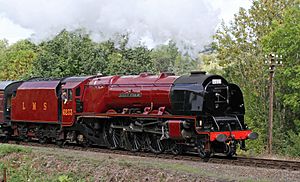William Stanier facts for kids
Quick facts for kids
Sir
William A. Stanier
|
|
|---|---|
| Born | 27 May 1876 Swindon, Wiltshire, England
|
| Died | 27 September 1965 (aged 89) Watford, Hertfordshire, England
|
| Spouse(s) | Ella Elizabeth Morse |
| Children | 2 |
Sir William Arthur Stanier (27 May 1876 – 27 September 1965) was a very important British railway engineer. He was the chief mechanical engineer for the London, Midland and Scottish Railway (LMS). He designed many famous and powerful steam locomotives.
Contents
Early Life and Career
William Stanier was born in Swindon, England. His father worked for the Great Western Railway (GWR). William went to Swindon High School and also to Wycliffe College for a year.
In 1891, he started working for the GWR, just like his father. He began as an office boy. Then, he spent five years learning how things worked in the railway workshops.
From 1897 to 1900, he worked in the Drawing Office as a draughtsman. This meant he drew plans for railway parts. In 1900, he became an Inspector of Materials.
In 1904, George Jackson Churchward made him an Assistant to the Divisional Locomotive Superintendent in London. This was a big step up. In 1912, he returned to Swindon as the Assistant Works Manager. By 1920, he was promoted to Works Manager.
Leading the LMS Railway
In late 1931, Sir Josiah Stamp, who was the chairman of the London, Midland and Scottish Railway (LMS), asked Stanier to join his company. Stanier became the Chief Mechanical Engineer (CME) of the LMS on January 1, 1932.
His main job was to design new, more modern, and powerful locomotives. He used all the knowledge he had gained from his time at the GWR in Swindon.
Stanier created many successful designs for the LMS. Two of his most famous designs were the "Black Five" mixed-traffic 4-6-0 and the 8F 2-8-0 freight locomotive.
His Princess Coronation Class 4-6-2 No. 6220 Coronation set a new British speed record. It reached 114 miles per hour. This beat the previous record held by another famous locomotive.
Stanier's Locomotive Designs
William Stanier, with the support of Sir Josiah Stamp, changed the way the LMS designed engines. The LMS had been using a "small engine policy." Stanier reversed this, leading to bigger and better locomotives.
Here are some of the locomotive designs Stanier introduced:
- LMS Class 2P 0-4-4T
- LMS Class 3MT 2-6-2T
- LMS Class 4MT 2-6-4T (3-cylinder)
- LMS Class 4MT 2-6-4T (2-cylinder)
- LMS Class 5MT 2-6-0
- LMS Class 5MT "Black Five" 4-6-0
- LMS Class 6P "Jubilee" 4-6-0
- LMS Rebuilt Royal Scot Class
- LMS Class 8P "Princess Royal" 4-6-2
- LMS Class 8P "Princess Coronation" 4-6-2 Pacific
- LMS Class 8F 2-8-0
- LMS Turbomotive
Later Life and Legacy
During World War II, Stanier worked as an advisor for the Ministry of Supply. He retired in 1944.
He was knighted on February 9, 1943, which means he received the title "Sir." When he retired, he was also made a Fellow of the Royal Society. This is a very high honor for scientists and engineers. Only two other locomotive engineers had received it before him.
He was also the president of the Institution of Mechanical Engineers in 1944. He was a vice president of the Stephenson Locomotive Society for many years.
Sir William Stanier passed away in Rickmansworth in 1965. He had married Ella Elizabeth Morse in 1906. They had a son and a daughter.
Stanier's designs had a big impact on British railways. The later standard steam locomotives of British Railways were heavily influenced by his work. The engineers who designed them used many of the ideas from his LMS locomotives.
There is a secondary school in Crewe named Sir William Stanier School in his honor.



